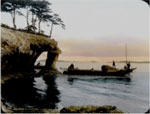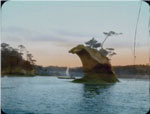Matsushima
Stephanie Carrera, Swarthmore College, Class of 2015
One of the Three Great Views of Japan, Matsushima has been involved in the visual culture of Japan since the 17th century, when the feudal lord Date Masamune restored the 9th century Zuiganji temple residing in Matsushima (Tomita, 1952). Popular 17th-century haiku poet Matsuo Basho famously wrote his response poem to Matsushima with awe that rendered him near speechless:
Matsushima ya
ah Matsushima ya
Matsushima ya
(Hamill, 1989)
Of the plethora of seasonal motifs in Japanese painting, three stand as perpetually relevant because they never fade in vibrancy during the passing of the seasons - the plum, the bamboo, and the pine (Clement, 1905). The pine represents longevity and is therefore used from palace decor to New Year's celebration imagery (Gerhart, 1999). That Matsushima carries such a culturally significant symbol on its many backs adds to the importance of the site.
On Matsuo Basho's journey through Japan to chronicle in poetry the many famous sites of Japan, he wrote of the divinity implicit in the many islands of Matsushima (Brownstein, 1990).
"There are countless islands-some rise up and point to Heaven, others bow low and crawl into the waves… Who could ever paint or describe in words the divine artistry of the Lord of Nature?"
With the popularization of the religion of Zen Buddhism, the concept of Ma became a much more prevalent force in Japanese art. The intervals between the many islands visualize the notion of Ma, the religio-aesthetic concept of the relationships among things incited by intervals between things (Pilgrim, 1986).
Sotatsu's "Waves at Matsushima" (Figures 2a and 2b) is an elegantly made pair of folding screens. The direct juxtaposition of the gold cloud and churning water display a duality of action from these two bodies of space. The pines of Matsushima are distinctly rendered, and the space between the islands reminds us of Mathrough the intervals between the rightmost islands separated by water that creates visual pauses for the viewer.
The next image is a woodblock print of the anticipated visit of the emperor to another of the locations on his tour of Japan (Kim, 2012). Even in gray scale, we see the presence of a gradation in the sky, possibly a sunset or sunrise. The islands evoke Ma once again because of their spacing. The powerful pines stand tall on the islands and support the longevity wished upon the emperor and his reign. The water is calm now while the sky evokes its dynamism. Boats float on the water and guide the viewer through the islands.
Although pushed into the realm of Western photography, this rendering of Matsushima shows a thoughtful understanding of Ma between the two islands and remembers the guiding companions in boats. While there are no foamy crests of waves, tonal difference separating the sea and sky emphasizes contrast.
The lantern slide was used as a teaching tool as well as a mode for collecting images among both Japanese and Western tourist audiences (Tucker, 2003). In this final version of Matsushima, Western photography and Japanese painting merge, so that the change in medium does not hinder decisions about color that inform the viewer of symbolism and culturally ingrained artistic references. The Islands in Figure 1 again show Ma, as seen in the rich blue of sea that nestles between islands and inside holes. The rich blues of the sunset sky and the foamy ocean show stark contrasts of two temperaments in these expansive spaces. The pines are richly green in their constant "bloom" and in the supplements in Figures 5 a-c, we see the recurring fishing boat motif that denotes human involvement.
This lantern slide of Matsushima (Figures 5a, 5b, and 5c) is a culmination of changing time and developing philosophies. On its own, it is a product of its era. It is a tool for teaching and sharing influenced by Westernization. However, the slide is not on its own: it is a stitch in the continuing visual history of a theme explored - the awe of Matsushima.







